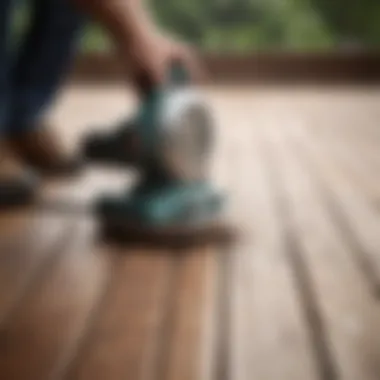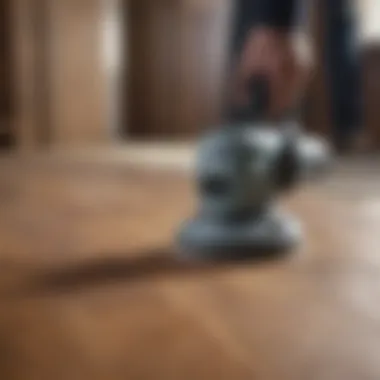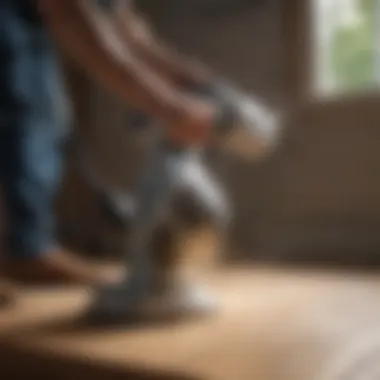Top Power Sanders for Effective Deck Restoration


Intro
Deck restoration is no small potatoes. A well-maintained deck not only enhances the aesthetics of your home but also extends its life, giving you a space to enjoy gatherings or simply relax in the sun. Power sanders stand as the backbone of this rejuvenation process, wiping away the old finish, prepping the wood for new treatments, and leaving a smooth surface ready to shine. However, with a veritable smorgasbord of tools available on the market, choosing the right power sander can feel like finding a needle in a haystack.
As we sift through the variety of options, this guide will walk you through the essential considerations and features that can make or break your deck restoration endeavor. We’ll dissect key models, discuss their suitability for different materials, and arm you with practical insights that can turn any DIY enthusiast into a pro.
Not only will we focus on the mechanics of each device—speed settings, power ratings, and dust collection systems—but also touch on important aspects of usability and maintenance to ensure your tool serves you well in multiple projects ahead.
With a firm grasp on what to consider, you’ll be better equipped to find the power sander that fits your needs like a glove, helping you transform your deck from drab to fab without losing your marbles in the process.
Understanding Power Sanders
Understanding power sanders is crucial for anyone looking into deck restoration. When it comes to refurbishing outdoor wood surfaces, selecting the right tool can be the difference between a job well done and a real headache. With so many options available, it is easy to get lost in the sea of choices. Power sanders are designed to make quick work of sanding, which can save time and effort when reviving a weathered deck. By understanding the various types of power sanders and their specific applications, you'll be better equipped to tackle the job and achieve a smooth, attractive finish.
What is a Power Sander?
A power sander is a tool that uses mechanical power to smooth surfaces by abrasion. It is an essential piece of equipment for any deck restoration project. Instead of relying on manual sanding, which can be incredibly tiring and time-consuming, power sanders allow homeowners and DIY enthusiasts to modernize their approach to surface preparation. They can remove old finishes, smooth rough patches, and prepare the wood for staining or sealing effectively.
Types of Power Sanders
Different tasks call for different types of sanders. Here are the main players in the power sander game, each bringing its own strengths to deck restoration.
Orbital Sanders
Orbital sanders, also known as finish sanders, offer a great balance of speed and smoothness, making them a popular choice for deck restoration. They use a circular sanding pad that moves in a random orbital motion. This unique characteristic helps in reducing swirl marks on the wood, ensuring a finer finish. Many homeowners lean towards this type as it's user-friendly and relatively quiet compared to other models.
However, while orbital sanders excel at final finishing, they may not tackle heavy-duty sanding jobs quite as efficiently as others. They are best suited for smaller areas or light to medium sanding workloads.
Belt Sanders
Belt sanders are the workhorses of the sanding family. They feature a continuous loop of sandpaper that moves rapidly, allowing for aggressive sanding. This makes them invaluable for removing old paint or varnish, as well as for leveling large surfaces—especially if you're facing a severely weathered deck. Their efficiency at stripping material is a key reason for their popularity in restoration projects.
That said, belt sanders need a steady hand. Their aggressive nature means it’s easy to remove too much material if not handled correctly. They can also leave marks if not used cautiously.
Detail Sanders
When it comes to fiddly spots, detail sanders shine. They’re compact and equipped with a triangular sanding pad, allowing them to get into tight corners and intricate designs on your deck. Detail sanders are ideal for touch-ups and intricate work that larger sanders can’t reach. Their user-friendly design makes them favorable for homeowners who might be intimidated by larger tools.
However, because they’re designed for precision rather than speed, detail sanders are not ideal for large surface areas. They’re more of a supplemental tool in the sanding toolkit rather than a primary choice for significant restoration tasks.
Random Orbit Sanders
Random orbit sanders combine the best of both worlds: they come equipped with a round sanding disc and a dual-action motor that moves the pad in a circular and random pattern. This characteristic ensures a smooth, swirl-free finish, making them a solid option for preparing surfaces for finishing.
Their versatility is a major advantage; they can be used on various materials and sizes of jobs. While they don’t cut as quickly as a belt sander, they provide a superior finish and are relatively user-friendly. One drawback is that they can be slightly pricier than some other types, but their balanced performance is often worth the investment.
Importance of Sanding a Deck
Sanding a deck isn't just a step in the maintenance checklist; it’s a vital practice that can breathe new life into your outdoor space. Many homeowners may underestimate the role that sanding plays in ensuring both the appearance and integrity of their decking material. Through careful sanding, one can achieve a multitude of benefits that not only elevate aesthetic appeal but also prolong the lifespan of the deck itself. Understanding these advantages can make all the difference between a lifeless deck and a vibrant outdoor retreat.


Enhancing Aesthetic Appeal
One of the most immediate benefits of sanding a deck is the enhancement of its aesthetic appeal. Over time, decks can accumulate dirt, algae, and various residues that dull their appearance. By sanding, you remove this layer of grime and reveal the fresh wood underneath, which gives a neat and polished look. The process smoothens rough patches, takes care of unsightly splinters, and can even help in bringing out the natural grain of the wood. A well-sanded deck acts as an inviting space for gatherings, barbecues, or simply enjoying the weather—with a fresh and clean appearance that is hard to ignore.
Sanding also prepares the wood for finishes, whether it be stains or sealants, ensuring even application and better absorption. This contributes further to the beauty of the overall design, making it easier to blend your deck with your home’s aesthetic.
Preventing Damage to Wood
Sanding is not just about looks; it's also about protection. Damage can creep into your deck without you even realizing it. Cracks and rough patches can allow moisture to seep into the wood, leading to rot and decay. A good sanding can preemptively address these issues, smoothing out imperfections and making the surface less hospitable to pests and the elements.
Moreover, by removing old finishes or peeling paint, you’re not only addressing surface issues but also potential long-term problems that may arise from improper sealing. Regular sanding helps maintain the strength and structural integrity of the wood, safeguarding your investment against unexpected deterioration.
Preparing for Sealing and Staining
Preparation is the name of the game when it comes to applying sealants and stains. Without proper sanding, these products may not adhere as well as they should. The deck needs to be smooth and relatively bare for the best results. Sanding creates a suitable surface for these finishes, allowing them to penetrate properly and offer maximum protection.
In the grand scheme of deck maintenance, prepping for sealing and staining post-sanding can lead to a more durable finish. This acts as a barrier against the damaging effects of weather, UV light, and moisture, ultimately extending the life of the wood. To sum up, investing a little time in sanding during restoration pays off immensely in terms of durability and prolonged beauty of your deck.
"A well-sanded deck is not just an investment in appearance; it is a commitment to the long-term health and enjoyment of your outdoor space."
Key Features to Consider in a Power Sander
When it comes to deck restoration, choosing the right power sander can make all the difference. It’s not just about having a sander, but having one that meets your specific needs. Certain features can enhance performance and ensure a smoother experience. Let’s explore the essential features that any solid power sander should have, allowing both homeowners and DIY enthusiasts to make smart choices.
Sanding Speed and Power
Speed and power are paramount when selecting a power sander. A sander with higher speed settings can accelerate the material removal process. This is especially crucial when dealing with rough and weathered decks. For instance, certain models have adjustable speeds that allow you to tailor your approach whether you are tackling stubborn stains or finishing a surface for a sleek look.
Power also matters. The motor should be robust enough to handle various tasks without overheating or bogging down. Typically, motors range from 1 to 4 amperes. A more powerful motor translates to efficient sanding, saving you time and energy.
Dust Collection System
A top-notch dust collection system cannot be overlooked. Sanding creates a lot of dust, which not only makes a mess but can also affect air quality. Many modern sanders come with built-in dust bags or ports that connect to a vacuum. A good dust collection system reduces cleanup and lets you focus on your project. Moreover, breathing in fine dust particles is harmful, so this feature is key for health and safety.
"A good dust collection system doesn’t just keep your workspace clean; it's a matter of health and improving visibility while you work."
Size and Weight
Size and weight play crucial roles, particularly for deck restorations involving large areas. Lighter models can be easier to maneuver, which can reduce fatigue during extended use. However, a larger model might provide increased stability and power. The balance between size and weight must cater to the specific tasks. For instance, if you’re working on a multi-level deck, a lightweight sander might be preferable for ease of handling.
Keep in mind: compact sanders can effectively reach tight spots, where larger models may struggle. Choosing the right dimensions is necessary to ensure capability without sacrificing comfort.
Versatility and Accessories
Finally, versatility is paramount. A good sander can handle a variety of materials and surface types. Some models even come with different sanding pads or accessories, allowing you to adjust for various projects beyond just decking.
Consider what attachments are available. For instance, having separate pads for rough sanding versus finishing can yield better results. Additionally, a sander with a variable speed control makes it perfect for varying types of wood and finishes, giving you flexibility in your work.
In summary, when choosing a power sander for deck restoration, consider the sanding speed, power, dust collection capabilities, size and weight, as well as versatility with accessories. These features will greatly enhance your efficiency and effectiveness, ensuring your deck restoration is smooth and successful.


Top Power Sanders for Deck Restoration
When it comes to breathing new life into an old deck, having the right tools in your arsenal is crucial. Power sanders play an integral role in this endeavor, making it not just easier to smooth out rough surfaces, but also ensuring that the finishing touches – stains and sealants – adhere properly. Choosing the best power sander can greatly impact the efficiency and efficacy of your deck restoration project.
These tools vary not only by type, as outlined earlier, but also in their features and suitability for different tasks. Specifically, each type of sander brings unique benefits that cater to different needs, from large surface areas to those tight corners that require finesse. Consequently, understanding which sanding machine stands out in the crowd can lead you down the path of successful home improvement, both in aesthetics and longevity of the wood.
Orbital Sanders Comparison
Orbital sanders are often favored for their versatility and user-friendliness. They compromise incredibly well between power and finesse, making them suitable for both heavy-duty and delicate tasks. Below, we will explore three distinct models within this category, highlighting what makes each of them worth considering for deck restoration.
Model A
Model A excels in sanding speed and is equipped with a user-friendly interface. This model’s variable speed settings make it a great choice for those who may need to adjust their sanding pressure on-the-fly. One of its standout features is the integrated dust collection system that minimizes cleanup times. However, there are complaints regarding its weight, which some users find a bit cumbersome during prolonged use.
Model B
When it comes to balance and maneuverability, Model B takes the prize. This sander is known for its lightweight design, allowing users to easily handle it even at awkward angles. Additionally, it comes with a superior grip that reduces hand fatigue. On the downside, its sanding power might lag behind, especially when used on tougher wood grains.
Model
Model C offers a two-in-one design, allowing the user to switch between sanding and polishing effortlessly. This sander is popular mainly due to its eco-friendly pad system that reduces waste. A notable downside, yet worth mentioning, is the replacement cost of pads seems higher compared to competitors, impacting long-term expense.
Belt Sanders Overview
Belt sanders are all about raw power and efficiency — excellent for stripping away layers of old paint or stains on your deck. Here, we compare two notable belt sanders that have garnered attention among deck restoration enthusiasts.
Model
Model D is recognized for its powerful motor and high-speed sanding capabilities. This sander can tackle tough materials with ease, making it an ideal choice for extensive restorations. One distinguishing feature is its adjustable belt tracking, which helps maintain a steady sanding movement. However, it tends to be on the heavier side, and some users report a learning curve when handling its speed.
Model E
Model E stands out for its budget-friendly pricing combined with impressive performance. Users appreciate its compact size, making it easier to store while still packing a punch for everyday projects. The only drawback appears to be the limited dust bag capacity, which requires frequent emptying during use, somewhat interrupting workflow.
Detail Sanders Analysis
Detail sanders are ideal for those tricky areas that need a gentle touch. They shine in corners and edges, providing the precision required for thorough deck restoration.
Model F
Model F features an impressive triangle-shaped sanding pad that allows users to navigate tight corners with ease. It’s lightweight and delivers a nice finish without much hassle. One key advantage is its affordable price point. However, one has to be cautious, as prolonged use can lead to overheating issues.
Model G
Model G is known for its ergonomic design, providing users with comfort during extended applications. This model features a tool-less pad changing system, making it very user-friendly. Still, it’s important to note that it may lack the power of larger sanders, making it less effective for extensive area restoration.
Evaluating Random Orbit Sanders
Random orbit sanders blend both random orbital and finishing capabilities, making them ideal for achieving a smooth surface before painting or sealing.


Model H
Model H provides a superb balance of power and portability. It comes with an innovative dust extraction system, earning some praise from users for keeping workspaces cleaner. Even so, some users may find the paddle switch to be a bit difficult to master at first, which could slow users down initially.
Model
Model I features a soft-start technology, allowing for smoother operation when beginning sanding tasks. Its adjustable speed settings are particularly appreciated for versatility. On the flip side, it has been criticized for its smaller dust bag, which might lead to frequent interruptions if not emptied regularly during extended use.
Safety Considerations When Using a Power Sander
When you dive into the world of deck restoration, safety should be at the forefront of your mind. Pulling out a power sander can seem like a straightforward task; however, neglecting safety measures can lead to accidents that can be easily avoided. Having the right knowledge and equipment ensures that your deck restoration project goes smoothly without the risk of injury.
Understanding safety considerations is not just about preventing accidents; it’s about maximizing efficiency and effectiveness as you work. Being properly equipped will not only enhance your performance but also give you peace of mind as you sand away the imperfections of your deck.
Personal Protective Equipment (PPE)
Before you even plug in your power sander, it’s crucial to gather your personal protective equipment. This gear acts as a line of defense between you and potential hazards such as dust, flying debris, and even the machine itself. Here’s a rundown of essential PPE for power sanding:
- Safety Glasses: Protect your eyes from sawdust and wood particles that can fly around while you work.
- Dust Masks or Respirators: These are vital for filtering out harmful particles from the air, especially if you're sanding treated wood or are sensitive to allergens.
- Ear Protection: Power sanders can be quite loud. Wearing ear muffs or plugs can help protect your hearing over extended periods of use.
- Gloves: Durable gloves can protect your hands from splinters and provide a better grip on the sander.
- Steel-Toed Boots: If you drop the sander, you won't want it landing on your toes.
Remember, while you may feel comfortable handling tools, accidents can happen in the blink of an eye. Having a good set of PPE is like putting on a seatbelt—an easy step that can save you from long-term injury.
Proper Setup and Usage
Setting up your power sander properly is another critical aspect to consider. A poorly configured machine can lead to uneven sanding or even become a safety hazard. Here’s how to ensure you’re using your power sander safely and effectively:
- Choose the Right Area: Sand in a well-ventilated space. If you can work outside, that's best. You want to avoid accumulating too much dust indoors.
- Inspect Your Sander: Before you start, check for any wear and tear. Ensure parts like the sandpaper are secure and in good condition. For instance, loose sandpaper can lead to accidents or subpar results.
- Understand the Controls: Familiarize yourself with all the settings and functions of your power sander. Knowing how to turn it on and off, adjust speeds, and switch attachments can streamline your work and avoid mishaps.
- Grip securely: When operating the sander, maintain a firm grip and keep both hands involved. This not only gives better control but also protects against sudden jerks.
- Maintain a Stable Position: Stay balanced and grounded as you work. Moving swiftly or awkwardly can lead to strains or loss of control.
- Keep it Clean: Regularly clear dust off the sander and your workspace to maintain visibility and efficiency.
"Safety isn’t just a policy—it's a practice that can save your life."
By taking these safety measures seriously, you not only protect yourself but enhance the quality of your deck restoration project. \ Paring gears with safety often leads to professional results, showing how critical these considerations really are.
End
In the realm of deck restoration, choosing the right power sander can be the deciding factor that transforms a weathered outdoor space into a stunning extension of your home. Understanding the nuances of each type of power sander is essential not only for achieving a smooth finish but also for ensuring the longevity of your deck.
When it comes to selecting equipment for deck restoration, several elements deserve attention. Firstly, the sanding speed and power of the sander can significantly impact efficiency, allowing you to spend less time on the job and more time enjoying your revitalized deck. Moreover, a robust dust collection system is not just a convenience; it keeps the workspace tidy and minimizes exposure to harmful dust particles that can pose health risks.
Equally crucial is the size and weight of the power sander. For homeowners engaging in DIY projects, a lightweight and easy-to-handle tool makes all the difference, especially during extended use. Portability can also enhance reach, especially when dealing with intricate deck designs and corners.
The importance of versatility and accessories should not be underestimated either. A sander that accommodates various attachments makes it easier to adapt to different restoration tasks, whether it’s dealing with larger deck boards or refinishing hard-to-reach nooks. The features of the sander collectively improve not only the workflow but the overall results.
"A good sander is the unsung hero of deck restoration; it’s not just about removing old layers but also about preparing the wood for years of enjoyment.”
In your quest for the ideal power sander, don't forget to weigh the value of safety along with functionality. Following proper setup instructions and utilizing Personal Protective Equipment (PPE) is not only smart but also essential to prevent accidents, allowing you to focus on bringing your vision to life without worry.
Ultimately, every aspect of power sanders—from technical features to safety considerations—plays a pivotal role in your deck restoration journey. Equipped with the right knowledge, you can confidently choose a sander that not only meets your needs but also enhances the beauty and functionality of your outdoor living space.
Final Thoughts on Choosing the Right Sander
Choosing the best sander for your deck restoration project might seem daunting at first, but breaking it down into essential features and considerations clarifies the decision-making process. It’s crucial to define your project requirements first—think about the size of the deck, the material, and the level of refinishing needed.
Take time to compare the options available in the market. Whether it’s an orbital, belt, or random orbit sander, understanding the specific advantages presented by each type will guide you towards the most efficient choice. For instance, orbital sanders excel in finish sanding, while belt sanders can tackle the heavy lifting in material removal.
Consider size and weight; a sander that’s comfortable to handle can make a world of difference during long sanding sessions. Being equipped with the right dust collection capabilities is another major plus that can’t be overlooked.
Remember, the house isn’t just a structure; it’s a space for memories. The right tools help to maintain and enhance the beauty of that space. Having a smooth, well-finished deck not only improves curb appeal but can boost the overall enjoyment of your outdoor environment. So choose wisely, apply the right techniques, and enjoy the satisfaction of your handiwork.















